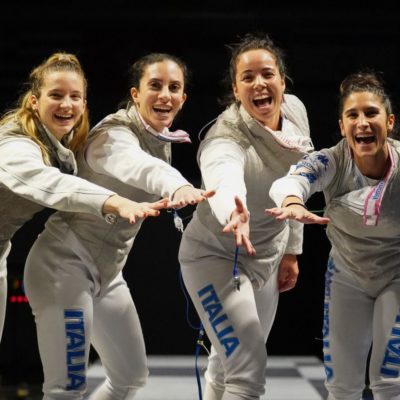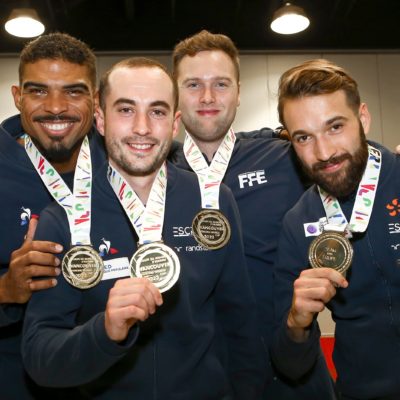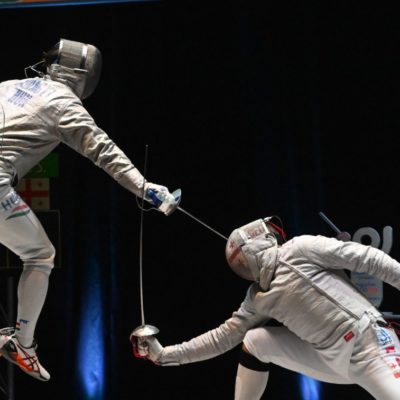This interview is the second of several that we will be featuring from 3 time Men’s Foil World Champion Sergei Golubitsky. Sergei takes some time to review the proposed rules changes to foil, where the game is going, and the role of the referee.
{mosimage}FN: At lower levels, there are a lot of foilists who complain about the flick and how it is given priority. Watching bouts at the high levels, do you feel this to be the case?Is the flick really something that is wrong with foil fencing?
SG: For those who haven’t seen my “Golden Bouts” video and new one “Once upon a time”: the percentage of flicks I make is very low. In my opinion a touch with thrust is more secure then a flick.
The points to consider are:
- The flick is performed faster than a touch
- it’s much more difficult to retreat after action finished by touch than the one by flick
- The flick gives you a chance to come much closer to opponent.
The advantage of flick is obvious.
When a fencer is going to finish his attack with flick it creats no problem. The problem appears when a fencer (fencer A) is walking forward, pretending to have right of way, in fact is waiting for “counter attack” of opponent (fencer B). Of course it’s important how fencer B is performing his attack on preparation (body language). Fencer A finishing his “attack” with flick (if he’d finish it with touch/thrust, his mistake would be too obvious for referee and point would be given against him. Therefore he has no choice but to finish with flick).
It’s very difficult to win a tempo against “flicker”.And again we’ve arrived at point when the role of referee is very important. He is the one who has to “read” intentions of fencer A. Attack which lasts 30 minutes isn’t attack anymore. Promenade isn’t attack. Fencing developed the way that arriving to the top you “forced” to use flick more frequent then touch. I’d say it’s because of poor technical and tactical repertoire rather than being up-to-date.
In the end of my career I returned to touching technique,while right after Junior age preffered flicks (at that time it was hot, it was a “new wave”). For the present Senior and Junior generation the fencing is good the way it is. But they didn’t see “the good old fencing” (I did. I even fenced with Romankov from 1989 thru 1991 for the USSR team.) It’s very popular these days complain about “oldies” which don’t understand anything in modern fencing.
I’d say that fencing 10, 20, 25 years ago was much more interesting than nowadays. Fencers like Gregory, Cerioni and others agree with me. So,assuming all this, I guess, some changes have to be done in today’s foil fencing.
{mospagebreak}
{mosimage}FN: In your new video “Once upon a time” you stated that foil bouts seem to go too fast with so many touches being scored in the first 3 minutes. What advice can you give to other fencers on how to scout out your opponent at the beginning of the bout?
Sergei: It’s not bad if you can always win everything and beat everyone within 3 minutes! It’s just great! But losing within 2-3 minutes isn’t too good.
If you have chance to study your opponent, seeing his bouts before your bout with him, you have to use this opportunity. Check out which parry he preferres and when. Look at things he makes in attack.
If you won’t let your opponent use his favorite things, you have 50% of success in your pocket. If you never saw him before, you should investigate his reactions in defense and in attack. Think fast and positive!
For more tips read my book “Fencing is my life” which comes out very soon. For more info go to www.gfc-world.netfirms.com or www.gfc-world.com.
FN: What kind of training regimen do you require of your students? (% footwork, bladework, partner drills, lessons, bouting, fitness). What fitness activities do you recommend outside of the fencing salle?
Sergei: The content of training and percentage of means depends on period of fencing season.
Here I tell you recommended % during the regular season (it differs from period when you train for the main start of season). Fitness activities should be done once a week. In my opinion Monday is the best day. This training should take 1,5-2 hours.
Typical training:
– warming up+stretching 15 min;
– footwork 15-20 min;
– targetwork 15-20 min;
– lesson 20-30 min;
– drills 30 min;
– bouting 60 min;
-fitness + cooling down + stretching 10-15 min.
Outside of the fencing salle I recommend running. It won’t be bad to run every day 20-40 min, if you have time.
Till next time,
Sergei Golubitsky





